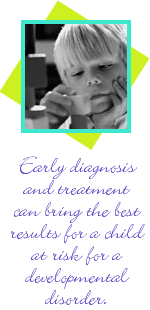|
When navigating the referral
process, parents and pediatric professionals must work together to pursue the healthiest developmental
outcome for a child at risk of a developmental disorder. This includes referrals
to, and follow up for, the following: Early Intervention, the local school district,
specialists, insurance, diagnostic testing, and working towards “what’s
next?”
For Physicians
Referral is not one step; it is an integrated process that requires persistence
on the part of pediatric professionals and parents. When navigating the maze of referrals, waiting lists, insurance forms, testing,
and specialists, many parents struggle. Parents must overcome both emotional
and practical difficulties as they move forward with the referral process. Accordingly,
it is imperative for physicians to work with parents as a “clinical quarterback” and
active participant throughout the referral process. Early diagnosis and intervention will bring the best results for a child at risk
of a developmental disorder, but without assistance, some families may face
a delay in receiving services. At the next office visit, you might review:
- Did you or the child’s parent make an intake appointment
with Early Intervention?
- Was a diagnostic referral made to a
specialist?
- Are there referrals that might be made through the family’s
insurance plan?
- What help does the family need?
- And, most importantly, how is the family doing?
For Parents
After a physician confirms the presence of a developmental delay or disorder,
parents have to contend with a range of emotions: grief, disbelief, anger, hope,
fear. Coming to terms with a child’s developmental delay or disorder can be a
lengthy process. While each parent responds differently, many parents recall
that the first steps towards self-education and action proved crucial not only
for the child’s well-being, but for their own. The only magical formula for a
child’s best outcome is an active and involved parent. Spend time with your child.
You don’t need a degree in psychology to help your child. Don’t hesitate to ask
your child’s physician for help. And don’t be afraid to lean on your family and
friends. Beyond love and acceptance, you will find that creativity and persistence
are invaluable tools. Speaking to parents of children
diagnosed with disabilities, one theme is clear:
act
now.
“I had to start moving forward before I even accepted
the diagnosis. I thought, “my son will prove you wrong’ and I made the
appointments with that intent.”
“I didn’t realize that everything took so long: specialists
had waiting lists, it took a while to even schedule an evaluation. I wish I’d
started earlier.”
“The best advice I have: talk to another parent who
has a child with developmental issues. They can help you navigate the maze,
and can give you the encouragement
you need to move forward.”
Once a parent is ready to move forward, it may be helpful to start a small notebook
where everything can be recorded: a schedule of upcoming appointments; names
of specialists; contact numbers for community resources; detailed notes from
conversations with clinicians; questions to ask at the next appointment; notes
on your child’s progress. One of the first lists for your notebook might be the following “to do” list,
which includes six crucial steps to take after a child has been identified as
having developmental delays:
Back to top
Next page =>
| 



